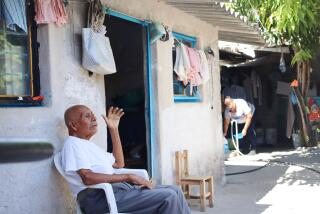Hurricane Katrina’s scars are on display at UCI gallery
Jonathan Alexander’s memories of Hurricane Katrina threatening his hometown in Louisiana 10 years ago seared his mind.
The UC Irvine English professor remembers worrying if his parents’ home on the Mississippi Gulf Coast, where they were living in retirement, had survived the flooding. Thankfully, it had.
But Alexander’s father didn’t make it. He had Parkinson’s disease and died from stress while being evacuated from the home in Metairie.
Alexander left the New Orleans suburb in 1993, after he graduated from Louisiana State University, but visited about once a year. He returned to New Orleans for his father’s funeral and again six months after the storm, which killed more than 1,800 people, to write an article for a Cincinnati publication called City Beat and document what he saw with photojournalist and colleague Jon Hughes.
Alexander, who at the time taught at the University of Cincinnati, roped fellow professor Hughes, who had previously photographed a war zone in Bosnia, into creating the visuals to accompany his writing.
“It’s kind of remarkable,” Alexander said. “You could still see a lot of devastation. Even when I was there earlier this year in February and March, there were still some parts of the city that had not been rebuilt and other parts that had been completely rebuilt. It’s amazing to see how long it’s taken for parts of the city that were affected to come back.”
About a dozen of Hughes’ photos from the trip are displayed in an exhibit called “Blood in the Water: A Katrina Remembrance,” curated by Alexander at UCI.
The gallery, which opened Friday and is free to the public, shows Hughes’ black-and-white-film photographs of boats on top of structures, overwhelming debris and door markings symbolizing how many people had died in a building. But there are also signs of hope, like a decorated Christmas tree planted in front of a house that had been destroyed and a statue of Jesus on the cross.
“When I saw it on the news, that was a small screen and I didn’t get a sense of it,” said Hughes, a professor emeritus at the University of Cincinnati. “I felt for the people and the tragedy of it all. I didn’t really know what to expect when I saw it physically, particularly six months later. I was taken aback by how much it looked like a war zone that I saw in Bosnia.”
Hughes suggests visitors focus on more than his photographs at the gallery.
“This isn’t just about the images,” he said. “People need to hear Jonathan’s story. The images represent his viewpoints and complement what he has gone through in trying to recover from his family experiencing this.”
Alexander said the exhibit, which focuses on storm surge damage and flooding from a levy breach, is meant to be a learning experience for people.
He said he believes that much of the flooding could have been prevented had New Orleans had a better levy system.
“Hurricanes are certainly natural phenomenons, but the flooding that occurred in New Orleans is something that, as someone who grew up in the area, we always knew that a powerful enough storm would breach the levy system,” Alexander said. “We want to raise awareness and make sure that people continue to remember that these sorts of things happen.”
If you go:
What: “Blood in the Water: A Katrina Remembrance”
When: Sept. 18 to Oct. 9; reception from 4 p.m. to 6 p.m. Oct. 1
Where: UC Irvine Student Center Viewpoint Gallery, 311 W Peltason Drive, Irvine
Cost: Free
Infomation: studentcenter.uci.edu/viewpoint-gallery/blood-in-the-water/
More to Read
Start your day right
Sign up for Essential California for news, features and recommendations from the L.A. Times and beyond in your inbox six days a week.
You may occasionally receive promotional content from the Los Angeles Times.







